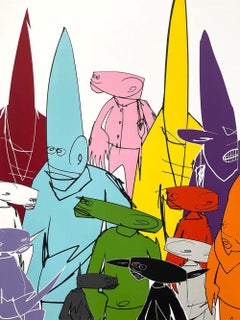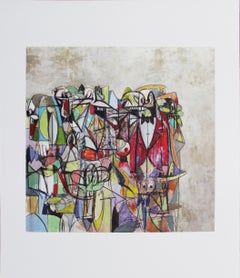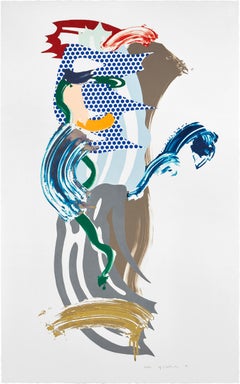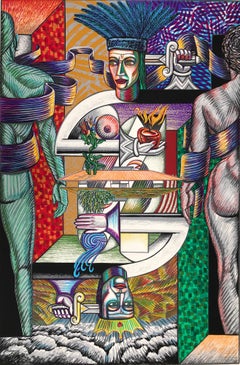EHC Fine Art Figurative Prints
to
3
2
1
Overall Width
to
Overall Height
to
2
1
2
1
3
3
1
1
1
1
2
1
3
Characterization poster
By Futura
Located in Washington , DC, DC
Beautiful poster featuring a colorful cast of Futura's characters including his iconic Pointman. Screen printed with 12 colors on high quality 100 lb Cougar Natural Cover paper, this...
Category
2010s Contemporary Figurative Prints
Materials
Screen
$1,880 Sale Price
20% Off
Plate 13, Compression IV
By George Condo
Located in Washington , DC, DC
Released as part of a portfolio in a limited edition of 400 on the occasion of George Condo's exhibition "Drawing Paintings" at Skarsketdt Gallery in 2011. Unsigned and unnumbered
S...
Category
2010s Abstract Abstract Prints
Materials
Offset
$2,280 Sale Price
64% Off
Plate 1 Comic Relief
By George Condo
Located in Washington , DC, DC
Released as part of a portfolio in a limited edition of 400 on the occasion of George Condo's exhibition "Drawing Paintings" at Skarsketdt Gallery in 2011. Unsigned and unnumbered
S...
Category
2010s Abstract Abstract Prints
Materials
Offset
$2,280 Sale Price
64% Off
Related Items
Blue Face from the Brushstroke Figures Series
By Roy Lichtenstein
Located in Miami, FL
Lithograph, waxtype woodcut and screenprint on 638-g/m cold-pressed Saunders Waterford Paper. From the "Brushstroke Figures" series, 1989. Hand signed rf Lichtenstein, dated ('89) a...
Category
1980s Contemporary Abstract Prints
Materials
Lithograph, Screen, Woodcut
Draw, by Paul Botello
By Paul Botello
Located in Palm Springs, CA
Visually, the design evokes a king playing card, reinterpreted through a Mesoamerican lens: Mayan‑style figures, swords, clouds, and other symbolic motifs are composed in a richly gr...
Category
1990s Contemporary Figurative Prints
Materials
Screen
Bacon, Le Boeuf, 1986
By Francis Bacon
Located in Fairfield, CT
Artist: After Francis Bacon (1909-1992)
Title: Le Boeuf, exhibition poster
Year: 1986
Medium: Offset Lithograph on premium paper
Size: 30.75 x 18 inches
Condition: Excellent
Notes: Published by Foundation Maeght
FRANCIS BACON (1909-1992) Francis Bacon has a distinctive style as a figure painter. In his mature style, developed in the 1950s, the paintings include images of either friends or lovers, or images of people found in movie stills...
Category
1980s Abstract Expressionist Abstract Prints
Materials
Lithograph, Offset
The Sprinters, for 1984 Los Angeles Olympics with official COA Lt Ed Hand Signed
By John Baldessari
Located in New York, NY
John Baldessari
The Sprinters, 1982
Limited Edition Offset Lithograph on Parson's Diploma paper
Signed in graphite pencil on the front. Accompanied by letter of authenticity from the publisher
36 x 24 inches
Unframed
Provenance:
Acquired as part of the complete SIGNED 1984 Olympic Lithographic Print Portfolio
Exhibition History:
Olympic Museum in Lausanne, Switzerland, 2017 (different edition)
Accompanied by a letter of authenticity from the publisher on Olympic Committee letterhead. This is one of 750 hand signed lithographic posters, published in 1982 to celebrate the 1984 Los Angeles Olympics...
Category
1980s Contemporary Figurative Prints
Materials
Offset, Lithograph
Black Rage, print with COA Signed 53/100 by Glenn Ligon Framed Black art, text
By Glenn Ligon
Located in New York, NY
Renowned contemporary conceptual African American artist Glenn Ligon
Black Rage (back cover), 2019
Silkscreen and digital print
Edition number 53/100
Accompanied by an official Certi...
Category
2010s Contemporary Abstract Prints
Materials
Digital, Screen
$5,950
H 14 in W 11.5 in D 1.25 in
Castelli Gallery poster, hand signed and inscribed by artist to Richard Feigen
By James Rosenquist
Located in New York, NY
James Rosenquist
Castelli Gallery poster (hand signed and inscribed by the artist to the art dealer Richard Feigen), 1980
Offset lithograph poster
Signed, dated and inscribed by Jame...
Category
1980s Pop Art Abstract Prints
Materials
Lithograph, Offset
Rare exhibition print (Hand Signed by Willem de Kooning), Estate of Alan York
By Willem de Kooning
Located in New York, NY
Willem de Kooning
de Kooning in East Hampton (Hand Signed), from Estate of Alan York, 1978
Offset lithograph poster (Hand signed by de Kooning)
Boldly signed in green marker on the f...
Category
1970s Abstract Expressionist Abstract Prints
Materials
Permanent Marker, Lithograph, Offset
Willem de KooningRare exhibition print (Hand Signed by Willem de Kooning), Estate of Alan York, 1978
$7,500
H 35 in W 25 in D 1.5 in
International Very Special Arts signed, inscribed Abstract Expressionist poster
By Paul Jenkins
Located in New York, NY
Paul Jenkins
International Very Special Arts Festival poster, 1994
hand signed and dated by Paul Jenkins
Measures: 37 inches (vertical) x 25 inches (horizontal)
Ships rolled in a tub...
Category
1990s Abstract Expressionist Abstract Prints
Materials
Offset, Ballpoint Pen, Lithograph
$385 Sale Price
44% Off
H 36 in Dm 6 in
Rare mid century modern Olivetti Fully Automatic Printing Calculator poster, '50
By Giovanni Pintori
Located in New York, NY
Giovanni Pintori
Olivetti (Fully Automatic Printing Calculator), 1951
Offset lithograph poster
Framed: held in original vintage metal frame
Evocati...
Category
Mid-20th Century Modern Figurative Prints
Materials
Offset, Lithograph
$1,000
H 27 in W 20 in D 0.5 in
"Marilyn Crying Diamond (Marmont Pink)" hand-pulled screen print on linen
By Russell Young
Located in Boca Raton, FL
"Marilyn Crying Diamond (Marmont Pink)" acrylic, oil-based ink and diamond dust hand-pulled screen print on linen by artist Russell Young. Depic...
Category
2010s Contemporary Portrait Prints
Materials
Linen, Ink, Screen
$33,600
H 62.7 in W 48.5 in D 2 in
Gershwin Brothers, after Larry Rivers
By Larry Rivers
Located in Fairfield, CT
Artist: After Larry Rivers (1923-2002)
Title: Gershwin Brothers, exhibition poster
Year: 1966
Medium: Lithograph on wove paper
Size: 37 x 26 inches
Condition: Excellent
Notes: Publis...
Category
1960s Abstract Expressionist Abstract Prints
Materials
Lithograph, Offset
Bacon, Portrait Isabel Rawsthorne, 2003 (after)
By Francis Bacon
Located in Fairfield, CT
Artist: Francis Bacon (1909-1992)
Title: Portrait Isabel Rawsthorne
Year: 2003
Medium: Offset Lithograph on premium paper
Size: 39.25 x 27.5 inches
Condition: Excellent
Notes: Publis...
Category
Early 2000s Abstract Expressionist Abstract Prints
Materials
Lithograph, Offset



